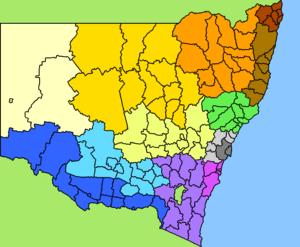Local government areas of New South Wales facts for kids
In New South Wales (NSW), Australia, local government areas (LGAs) are special zones where local councils manage community affairs. These areas can be called cities, towns, municipalities, regions, or shires. They handle things like local services and rules, as allowed by the Local Government Act 1993.
Local councils offer many services to their communities. They manage general tasks like administration, health, and community facilities. They also look after parks, cultural activities, and roads. In some country areas of NSW, councils also provide services like water supply, sewerage, gas, and even abattoirs (places where animals are processed for meat).
The Government of New South Wales oversees these local areas. Sometimes, areas are merged together, either by choice or by force. An area becomes a "city" when the Governor of New South Wales officially declares it one. Some areas still use old names like "municipalities" (often inner-city or smaller towns) or "shires" (usually rural or outer suburban areas). Many councils now simply call themselves "councils," like Northern Beaches Council. The smallest LGA in NSW is the Municipality of Hunter's Hill.
Contents
Understanding Local Government History
Early Laws for Local Areas
Local government in New South Wales started even before the state had its own responsible government. The Sydney Corporation was set up in 1842. This elected group was in charge of basic services like street lighting and drainage.
Later, the Municipalities Act of 1858 created a system for local government. Over the years, new laws were made to improve how local areas were managed. The Local Government Act of 1993 is the most recent one.
This 1993 law brought in important changes. It made councils more responsible to their communities. They had to report better and involve people in big decisions. The law also clarified the roles of elected councillors and staff. Councillors make the main decisions, while general managers handle daily tasks and staff.
Changes to Local Government Areas Over Time
| Year | Number of LGAs |
Ref. |
|---|---|---|
| 1906 | 327 | |
| 1910 | 324 | |
| 1991 | 176 | |
| 1992 | 177 | |
| 2001 | 173 | |
| 2004 | 152 | |
| 2016 | 132 |
The NSW Government has often reviewed how local government areas are set up. These reviews aim to make councils work better. Early changes included allowing women to vote in local elections and making land valuation systems the same everywhere.
Reviews in the 1970s and 1980s
In the 1970s, a review called the Barnett Committee suggested merging many councils. The idea was to create stronger local areas. Although the government first said no, later, 38 councils were merged into 17.
Another review in 1978, known as Bains, changed how councils were managed. It led to councils using a "corporate management" style. This meant councils planned their work as a whole. It also gave more power to general managers, making councillors focus on policy.
The 1980s review looked at merging rural and regional councils. The goal was to make services more efficient by combining resources.
Reviews in the 1990s and 2000s
In the 1990s, the government encouraged councils to share resources. Some councils chose to merge to avoid being forced to combine later.
In the early 2000s, there was a review of Sydney's inner-city councils. Even though mergers were suggested, none happened at first. However, after the 2003 state election, the government changed its mind. It started to force some councils to merge. This led to new "super" councils in some areas.
Recent Changes in the 2010s
In 2013, the NSW Government released a report called Revitalising Local Government. This report looked at how well local councils were doing. It checked their finances and ability to serve their communities. The report made 65 suggestions to the government.
In 2014, the government responded to the report. It started talking to councils about merging. In 2015, the NSW Independent Pricing and Regulatory Tribunal (IPART) reviewed proposals from councils. They wanted to make sure councils were "Fit for the Future."
IPART found that many councils in Sydney and regional NSW were "not fit." This was often because they didn't suggest merging, even though it could help. IPART suggested reducing the number of councils from 152 to 112 through mergers.
After considering feedback, the government decided to create new councils. On 12 May 2016, Premier Mike Baird announced 19 new councils were formed immediately. These were created by merging existing ones. The Governor of New South Wales officially declared these new areas.
However, some councils did not agree with the mergers. For example, Strathfield Council went to court to stop its proposed merger. Other councils like Mosman and Woollahra also challenged the government's plans. While some challenges succeeded, the NSW Court of Appeal later dismissed Woollahra Council's appeal, meaning its merger proposal was valid.





